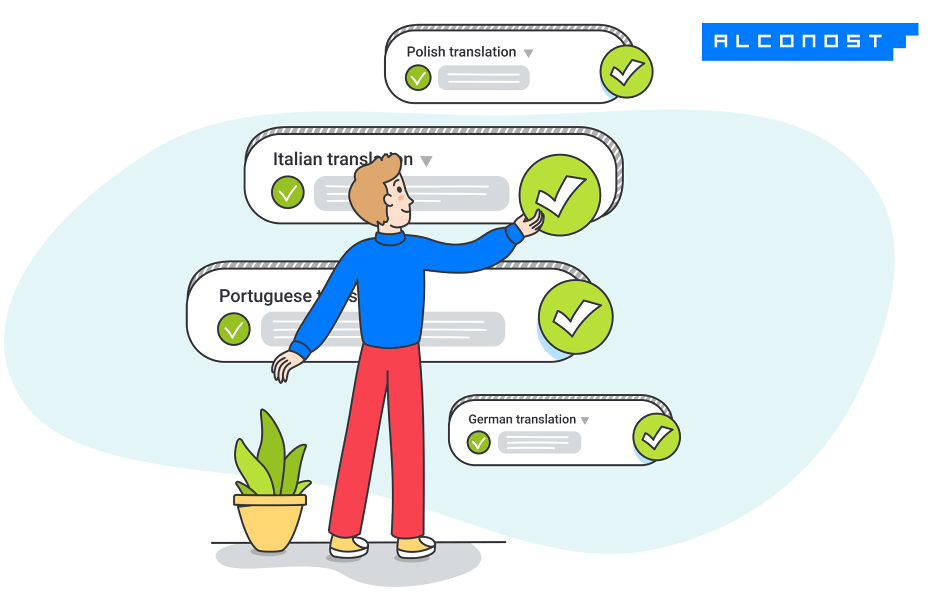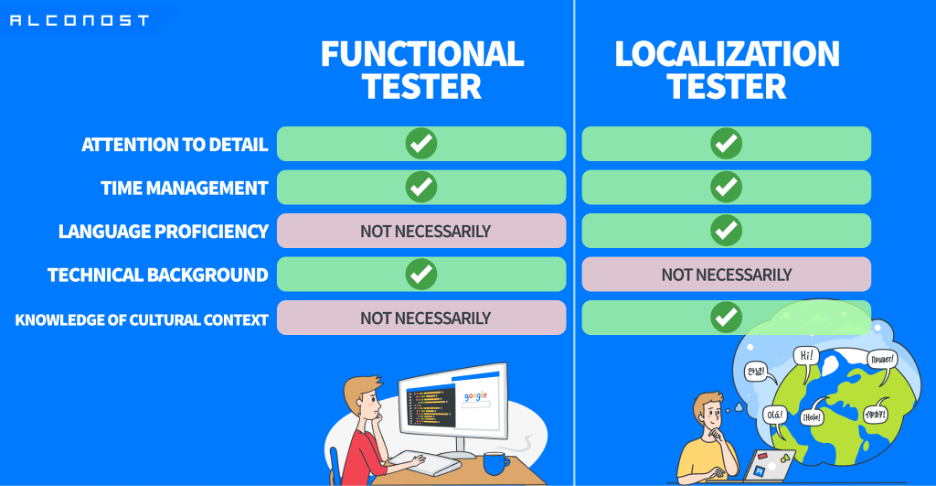- Resource Center
- Professional Development
- Articles & Videos
- Localization Testing: A Hidden Goldmine Beyond Localization and Testing
13 December 2022
| by Alconost
Localization Testing: A Hidden Goldmine Beyond Localization and Testing

Sign up for our newsletter on globalization and localization matters.
As a developer, you may have implemented functional testing of your product; possibly you've even done it yourself. We’ll also assume that you’ve implemented localization into your product, or at least you're considering it. But did you know that high-quality localization involves localization testing as its final step?
Here at Alconost we’ve been localizing games, apps, and websites for 18 years. We've seen the pitfalls of localization and localization testing, and that’s why we’ve decided to share them with you. Read on to understand what localization testing services are and how to prepare for localization testing.
What is localization testing?
Localization testing is a thorough inspection of the translated app, game, website, or other product for the purpose of ensuring that it contains no semantic and contextual errors, mistranslations, or linguistic and visual issues. Localization testing also checks for correct usage of date and time formats, UI elements, currencies, measurements, punctuation marks, and overall vocabulary.
Localization testing helps identify and eliminate semantic and technical errors in a product’s textual content before the localized version of the app or game reaches users.
How is localization testing different from functional testing?
Which type of testing should be done first? Can you assign both functional and localization testing to a single person? Let’s find out how these two types of testing coexist, and what skill sets you should look for when hiring skilled professionals for both roles.
Functional testing
Functional testing ensures the proper operation of each application feature. It involves checking the website, game, or app against predetermined standards of performance. In short, this type of testing looks at whether the app or system is functioning according to the technical expectations outlined.
Functional testers have a solid technical background under their belt. Aside from an impressive hard skill set, this type of testing requires attention to detail and strong time-management skills. But it doesn't require delving deep into every intricate nuance of the product’s context, or of the target market’s cultural aspects.
Localization testing
In contrast to functional testing, localization testing is less a technical procedure than it is a careful read-through to check how content will be perceived.
Testing of this type can be conducted either by going through the product using scripted scenarios provided, or by checking screenshots of the product in use. Errors that localization testers typically look for include:
- Untranslated or incorrectly translated text
- Inconsistency or inappropriate use of terminology — for example, different names used for the same function or object
- Inconsistencies in style between the translation and the source text
- Errors in grammar, spelling, and punctuation
- UI issues — for example, when localizing from English, keep in mind that text in some target languages (such as German) may not fit in the space originally allocated<
- Incorrect rendering of specific characters, such as glyphs
- Incorrect formatting of numbers, currencies, and dates — for example, 9/5/2022 refers to the 9th of May in European countries, but it means September 5 in the USA
- Errors that make further testing impossible — for example, a game constantly crashes at a certain point or when opening a certain window
If you’ve been paying close attention, you may be a little confused by now. Doesn’t the last point in the list above refer to the kind of bugs that functional testing should deal with? Absolutely, and this is where functional and localization testing intersect. But our advice is not to rely on localization testing alone. While localization testing does indeed help to detect critical functional bugs, localization testers simply don’t have the technical background to alter the code to make the product work properly. And vice versa: while functional testing is crucial for localized versions of any product, functional testers are usually not native speakers with a thorough understanding of the target languages. Consequently, without native speakers to check your localization you can never be sure whether your product is truly ready to be introduced to a foreign audience.
In a nutshell, the reason why a functional tester is unlikely to succeed in localization testing and vice versa is because these two services require different skill sets, as you can see in the table below.

So don’t hyperfocus on minimizing expenses — as you can see, functional and localization testing are designed to check different aspects of the product.
When preparing for an international launch, both localization and functional testing are vital because they ensure that no technical or linguistic errors slip by before the release. Testing in general is designed to ensure the best first impression possible when your product goes live, so we recommend that you not neglect testing, either functional or linguistic!
Automation, AI, & localization testing services
Combining automation with manual operations is a common practice for functional testing, where creating automated test scripts is recommended to accelerate the process. Handy tools that simplify routine tasks are also widely used in localization. Glossaries, computer-aided translation (CAT) tools, and translation management systems (TMS) help translators do the bulk of the initial work. With localization testing, however, it's not quite that easy: here you need someone from the target culture who's a native speaker of the target language to do the bulk of work.
Localization testing is the final step in the localization workflow, and it is still humans who put the finishing touches on the translation before it goes live.
The chief purpose of automation is to simplify the process and reduce the client’s expenses. However, you can actually cut them down yourself at the stage of preparation for localization and localization testing.
How to prepare for localization testing
- Long before the localization stage, develop your product with internationalization in mind. Write code that allows for bidirectional text and non-Latin typographic features, and which supports different time formats, numeric formats, sorting, etc. Use Unicode to allow for different character code architectures.
- Once you implement localization into a test build, outline a clear methodology for testing so that neither you nor the localization testers miss anything. Prepare documentation and plan how the game, app, or website will be tested. This helps tremendously, and this kind of documentation doesn't have to be humongous.
- If you need particular language versions to be tested with certain crucial nuances in mind, outline separate testing steps for those languages.
- For , prepare a separate build for testers with built-in cheat codes so the translators can easily play through it. In addition to cheat codes, you can also provide a pre-recorded gameplay video.
- If your project requires special equipment (such as a VR headset), it’s in your best interests to provide it so that the language service provider can select a translator based on their niche experience rather than on whether they have a rather uncommon piece of equipment. For these cases you'll also need to provide technical support for the device on occasions when the test build breaks down or gets buggy and prevents translators from conducting further testing./li>
- If your project is a game, help localization testers to get into the spirit of it by at least showing them a game trailer. If your project is an app or service, give testers some clues on style — for example, whether users should be addressed formally or informally. This is especially important when the source language is English, which has a universal 'you,' and the target language is French, Spanish, or German, where there are specific forms of 'you,' depending on how formal or informal you need to be.
We wouldn't say that preparation is something you can’t skip. But consider that a localization testing company usually bills at an hourly rate for localization testing services. If the localization quality assurance tester has to slog through the entire game or app to check one screen of dialogue, you'll simply pay for more hours than you could have. Simplifying the process in advance means you save yourself money.
Final thoughts: What makes localization testing a worthwhile investment?
Human beings are social animals who thrive on communication, but that communication differs from one culture to the next. How your product communicates with its end users determines their loyalty. Localization testing is crucial because it ensures that your product speaks your users’ language, eliminates potentially offensive or inappropriate jokes, and embraces the power of local humor. If your users enjoy your high-quality product enough to stay and keep using it, they’ll be sure to tell their friends about it, as well!
Do you want to contribute with an article, a blog post or a webinar?
We’re always on the lookout for informative, useful and well-researched content relative to our industry.

Liza Dziahel
Liza is a Content Manager at Alconost, a global translation and localization agency that boasts a pool of 600+ native-speaking translators that work with a total of 100+ languages. Liza writes marketing and industry-specific content, and manages Alconost's digital communication channels, such as its blog, social media, and community discussions.


